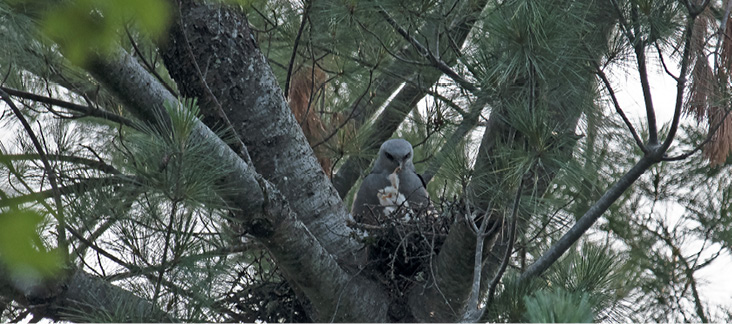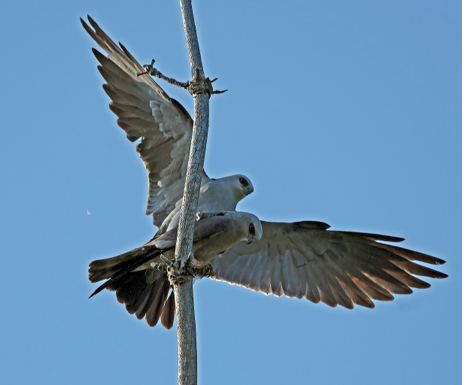Steve Mirick

Mississippi Kite with dead chick. Photograph by Deb Powers.
Mississippi Kites in New Hampshire had a difficult year in 2021. On the plus side, all four pairs that attempted to nest in 2021 returned to the same territories where they had nested previously, but unfortunately we were able to confirm success in only one of the four territories. The kites were first made famous in 2008, and 2021 is at least the thirteenth consecutive year in which between one and four pairs have nested in New Hampshire in this isolated, rare, nesting colony.
Durham
The Madbury Road territory was first noted in 2017, and 2020’s nest successfully fledged one chick as is the norm. In no breeding season has there ever been more than a single chick in a nest in New Hampshire. This year, 2021, the pair moved the nest back down the street to the same location where they nested three years ago. They nested in the same white pine tree in the same backyard as in 2018. Deb Powers found the nest this year. The homeowners were gracious and welcoming—as they were in 2018—of the birds and birders to visit. But the nest did not succeed. The incubation start date was not documented but hatching occurred roughly on June 30. July started with cold wet weather and this combination likely led to the death of the recently hatched chick. Deb Powers captured the horrific end of this nest on July 6 with a photo of what appears to be an adult trying to remove the dead baby from the nest: <https://www.flickr.com/photos/143862779@N08/51295275588>.
Newmarket
This specific Newmarket territory was first noted in 2018. Last year, the kites nested high up in an oak tree and the nest failed for unknown reasons. This year, the pair returned and quickly got to work. Dan McCoy captured them copulating on May 21st:<https://macaulaylibrary.org/asset/341082111>.
But after that, sightings of the birds became intermittent. Despite a few birders searching all summer, no territory, nest, or fledged young were found. If they built an undiscovered nest, I believe the pair were not successful in fledging a chick.

Mississippi Kites copulating. Photograph by Deb Powers.
Stratham
This territory was first noted in 2017 and 2020’s nest successfully fledged one chick. In 2021, they moved the nest again to a new location into the side yard of a different home in the neighborhood. The nest was placed in a black cherry tree and was discovered by Chris Duffy. The black cherry was a new species of nest tree for the kites in New Hampshire, which have now used maple, hickory, oak, pine, and cherry trees for their nests:<https://macaulaylibrary.org/asset/350022551>.The nest was not easily seen and the neighbors were not happy about birders, so the nest was not well documented. Incubation started somewhere during the first week of June and hatch date was sometime on or before July 15. The chick was doing well in the nest and was last reported on August 26 when it was roughly 42 days old. No one saw it fly but it is presumed to have fledged due to its age. This is the only fledged Mississippi Kite in the summer of 2021.
Greenland
This territory was first noted in 2020, when a pair of kites nested successfully in a hickory tree, raising a single chick. The nest fell down over the winter; however, the pair returned and rebuilt the nest in the same crotch of the tree in 2021. Sightings were few after the nest was built, however, and incubation was never observed. We do not know what happened here. Sightings of one or possibly two birds were reported from time to time, but no evidence of a renesting attempt was found. It is purely speculative as to what happened; however, a pair of Cooper’s Hawks successfully raised a family in the immediate vicinity, and I wonder if there could have been conflict between the two species. Regardless, we do not know if they built another, undiscovered nest, but I believe they were not successful if they did.
No other hints of new territories were uncovered. There may have been three birds at the Stratham nest site on a couple of occasions. This was not conclusive, and it also may reflect one of the adults from the Greenland territory.
Thank you to Deb Powers, Chris Duffy, Dan McCoy, Ed Norton, Sheila Graydon, and the homeowners for their help and cooperation in following these birds.